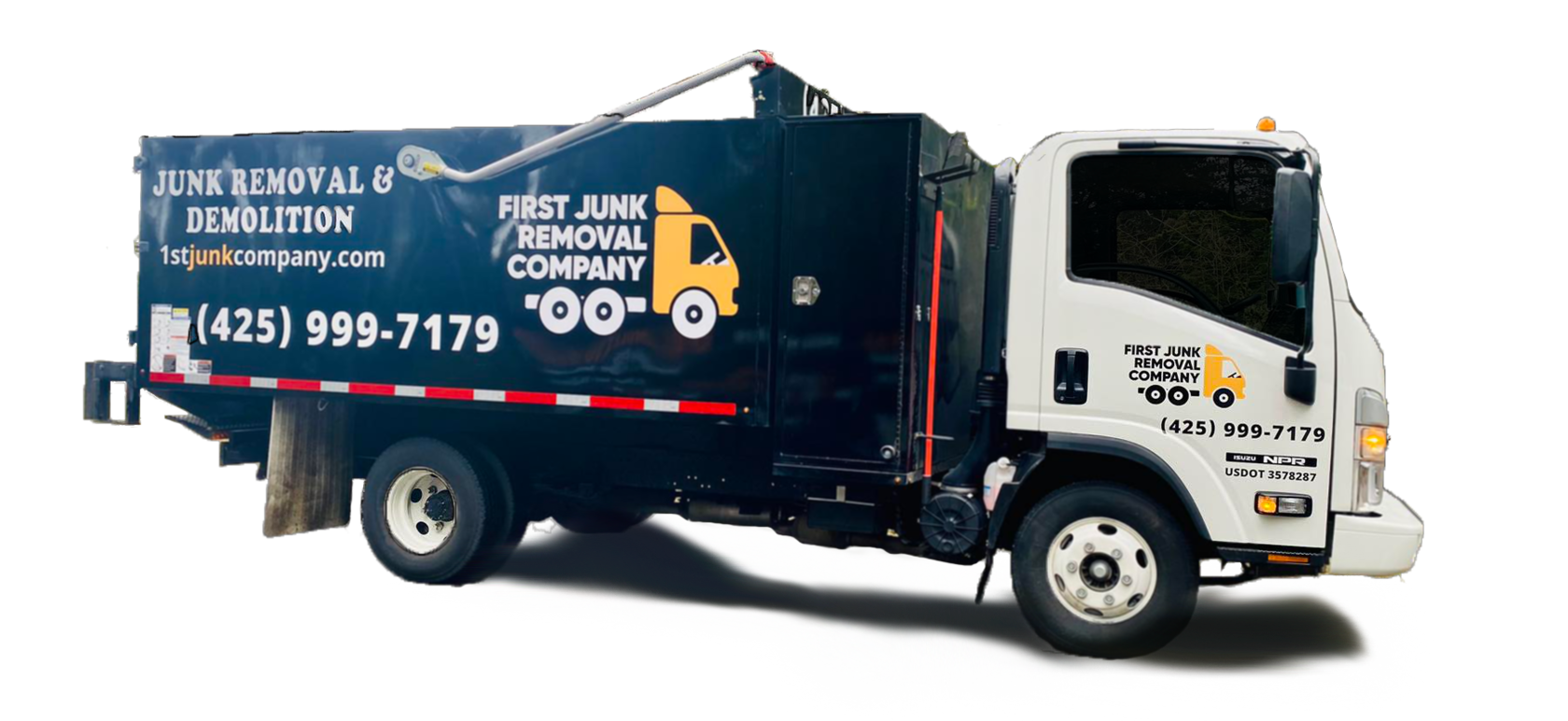24/7 Customer Service 1-425-999-7179
Our First Junk Removal Company makes junk removal safe and easy.
HOT TUB REMOVAL
No credit card required ∎ 24/7 customer service at 1-425-999-7179
BOOK US ONLINE
Hot Tub & Jacuzzi Removal Service
Was there a time in your life, maybe 10 years ago or so, when you thought buying a hot tub for your home would be a great investment? You only used it a few times a year and the rest of the time it just collected dust?
Don't worry if this sounds like you, you are not alone. Many hot tubs and jacuzzi have not been used or maintained by homeowners for years. They haven't been used for so long that the hot tub eventually turns into junk. That's when the real problem comes in. What will you do with the old jacuzzi?
Don't worry if this sounds like you, you are not alone. Many hot tubs and jacuzzi have not been used or maintained by homeowners for years. They haven't been used for so long that the hot tub eventually turns into junk. That's when the real problem comes in. What will you do with the old jacuzzi?

Hot Tub & Jacuzzi Removal
We take care of heavy lifting, loading, disassembling and hauling.
If you want to get rid of your old hot tub, get ready for the hard work - the average hot tub weighs over 500 pounds!
Even with a small group of friends, spa removal can be difficult. Why not save tons of time and effort by taking advantage of the hot tub removal service from First Junk Removal Company! We take care of heavy lifting, loading, disassembling and hauling.
As a customer, all you have to do is sit back, relax and watch your old junk hot tub getting out of your life for good.
Even with a small group of friends, spa removal can be difficult. Why not save tons of time and effort by taking advantage of the hot tub removal service from First Junk Removal Company! We take care of heavy lifting, loading, disassembling and hauling.
As a customer, all you have to do is sit back, relax and watch your old junk hot tub getting out of your life for good.

We make sure that your old tub end up in a recycling facility and be disposed of in an eco-friendly way.
We haul any of those unwanted items you have, including: Hot Tub Covers, Steel & Fiberglass Tubs, Hot Tubs,
Above Ground Spas, Jaccuzi.
We haul any of those unwanted items you have, including: Hot Tub Covers, Steel & Fiberglass Tubs, Hot Tubs,
Above Ground Spas, Jaccuzi.

We Remove :
- Hot Tubs
- Steel & Fiberglass Tubs
- Hot Tub Covers
- Above Ground Spas
- Jacuzzi
Items We Do Not Accept:
Items we DO NOT ACCEPT are hazardous materials. This including chemicals, gasoline, oils, paints, solvents, asbestos or asbestos containing materials, full propane tanks or any types of toxic waste.
We are family owned and operated. Licensed, insured and bonded professionals. We promise to get the job done fast, efficient and with transparent price.
We are family owned and operated. Licensed, insured and bonded professionals. We promise to get the job done fast, efficient and with transparent price.

FAQ:
Taking out the hot tub is not as easy as taking out the trash. Hot tubs are large, almost impossible to move on your own, and generally not taken to recycling depots or landfills.
There are several ways to get rid of your old hot tub, including:
If you don't want to rent the hot tub yourself, you can always call First Junk Removal Company. We take on all the hard work right where it is.
Best of all, recycling and proper disposal of the hot tub is a priority, so you don't have to worry about them taking up space in the landfill.
There are several ways to get rid of your old hot tub, including:
- Sell it to a dealer
- Selling online or at a yard sale
- Hire a garbage disposal company to help remove it
If you don't want to rent the hot tub yourself, you can always call First Junk Removal Company. We take on all the hard work right where it is.
Best of all, recycling and proper disposal of the hot tub is a priority, so you don't have to worry about them taking up space in the landfill.
To prepare the spa tub for removal, there are a few things you need to do beforehand:
Moving a spa bath is not a one-man job. We'll be happy to help you just contact us and your junk will be gone!
- Disconnect the power supply.
- Drain all the water from the tub.
- Disassemble all parts of the spa such as pumps, heaters, electricity, and plumbing.
- Pack the bath accessories separately.
- Clear a path wide enough to accommodate the bathtub.
Moving a spa bath is not a one-man job. We'll be happy to help you just contact us and your junk will be gone!
Moving a hot tub is more than one person's job. Depending on the size of your spa, you may need special tools to help move it. Even if you have a group of friends ready to help, finding a spot for a hot tub can be trickier than it sounds.
Leave the hard work of a professional junk removal company. If you need Hot Tub removal services, call First Junk Removal Company and we'll take on the hard work.
Leave the hard work of a professional junk removal company. If you need Hot Tub removal services, call First Junk Removal Company and we'll take on the hard work.
Hot tub removal differs from a regular bathtub removal in just a few factors: the need for competent shutdown, blocking a number of functions, and design features of the jacuzzi.
The bath itself can be made of acrylic, steel, cast iron, or porcelain. The most common designs are made from acrylic, since it’s the most affordable in terms of cost, warm to the touch, and capable of taking any conceivable form. Acrylic whirlpool bathtubs can be in the form of a regular or sit-down bathtub, a small pool of rectangular, triangular, oval, or even round shapes. Fantasy forms with a wide step bench – are also a very popular option. Recreating such forms in cast iron or porcelain would cost a lot of money.
The bath itself can be made of acrylic, steel, cast iron, or porcelain. The most common designs are made from acrylic, since it’s the most affordable in terms of cost, warm to the touch, and capable of taking any conceivable form. Acrylic whirlpool bathtubs can be in the form of a regular or sit-down bathtub, a small pool of rectangular, triangular, oval, or even round shapes. Fantasy forms with a wide step bench – are also a very popular option. Recreating such forms in cast iron or porcelain would cost a lot of money.
Inside the bath, there are controlled or non-controlled jets, into which under-pressure water and air are supplied through special tubes, providing a pleasant massage feeling and the effect of “boiling water” in the jacuzzi. The water pressure in the nozzles is quite significant and if you have not shut off the valve that supplies water in advance, a lot of unpleasant surprises await you. It is better to carefully inspect all water connections; often nozzles and other pressure elements have their own separate power supply and, in some cases, a separate additional pump.
After you have turned off all the water, hot and cold, supplied to the taps, showers, and jets, turn off the electricity. With proper installation, a separate machine is installed on the jacuzzi and shower. In this case, it will be easy to de-energize the devices. It makes sense to refer to the technical documentation to know if you have forgotten about any steam generator or sauna effect for sure.
When removing the bath itself, it is best to cut it into pieces, along with a frame, an insulating pillow, and a foam base. The weight of the bath together with the frame is from (“is from” = “ranges from ”) 200 to 800 kg, so sawing the bath is the best option.
In some cases, a hot tub may have a concrete or brick base. This fact must be kept in mind and some care must be taken when sawing a hot tub with a power tool. The concrete base is broken with a sledgehammer and taken out in garbage bags.
It is worth noting that the jacuzzi removal requires professional knowledge, great physical strength, and endurance, as well as a professional, and rather expensive set of protective clothing. Therefore, in order to avoid embarrassing situations, all the removal and hot tub recycling works are always better to be held by professionals.
After you have turned off all the water, hot and cold, supplied to the taps, showers, and jets, turn off the electricity. With proper installation, a separate machine is installed on the jacuzzi and shower. In this case, it will be easy to de-energize the devices. It makes sense to refer to the technical documentation to know if you have forgotten about any steam generator or sauna effect for sure.
When removing the bath itself, it is best to cut it into pieces, along with a frame, an insulating pillow, and a foam base. The weight of the bath together with the frame is from (“is from” = “ranges from ”) 200 to 800 kg, so sawing the bath is the best option.
In some cases, a hot tub may have a concrete or brick base. This fact must be kept in mind and some care must be taken when sawing a hot tub with a power tool. The concrete base is broken with a sledgehammer and taken out in garbage bags.
It is worth noting that the jacuzzi removal requires professional knowledge, great physical strength, and endurance, as well as a professional, and rather expensive set of protective clothing. Therefore, in order to avoid embarrassing situations, all the removal and hot tub recycling works are always better to be held by professionals.
Dismantling a hot tub is a process that should be left to professionals. Its complexity lies in the fact that in addition to the usual shutdown of water, it is required to dismantle the components of the bath, turn off the electricity, remove the tiles around the tub, remove the structure, and sometimes even cut it.
At the same time, the dismantling of the jacuzzi must be done with care so that when the structure is disposed of, the room is not damaged. All this is complicated by the fact that the average weight of a hot tub can reach up to 300 kg.
The amount of work to dismantle the jacuzzi, as well as the price of the work, is determined by taking into account many factors, after inspecting the bath.
Professional plumbers are able to perform high-quality dismantling of the jacuzzi, as well as other work related to plumbing. Experienced workers will come on call and assess the condition of the hot tub, hoses, and wires. Dismantling work, the possibility of removing tiles around if necessary, and other points will be discussed with the customer.
Work is carried out in compliance with safety requirements and with care for the design.
Repair and replacement of an old bathtub with a new one, or breakage of a jacuzzi, the reasons for hot tub disposal are different. But, it is better to entrust the recycling work to a specialized company specializing in this type of work.
When dismantling such a structure, the qualifications and professionalism of employees are important. Such companies employ only experienced plumbers who will do their job competently and accurately.
At the same time, the dismantling of the jacuzzi must be done with care so that when the structure is disposed of, the room is not damaged. All this is complicated by the fact that the average weight of a hot tub can reach up to 300 kg.
The amount of work to dismantle the jacuzzi, as well as the price of the work, is determined by taking into account many factors, after inspecting the bath.
Professional plumbers are able to perform high-quality dismantling of the jacuzzi, as well as other work related to plumbing. Experienced workers will come on call and assess the condition of the hot tub, hoses, and wires. Dismantling work, the possibility of removing tiles around if necessary, and other points will be discussed with the customer.
Work is carried out in compliance with safety requirements and with care for the design.
Repair and replacement of an old bathtub with a new one, or breakage of a jacuzzi, the reasons for hot tub disposal are different. But, it is better to entrust the recycling work to a specialized company specializing in this type of work.
When dismantling such a structure, the qualifications and professionalism of employees are important. Such companies employ only experienced plumbers who will do their job competently and accurately.
How our service works:
1. Schedule your First Junk Removal Company service online or by calling 1-425-999-7179.
2. We will call you 20-30 minutes before your scheduled time to let you know exactly when to expect us.
3. When we arrive, we'll take a look at the items you want to be removed and provide you with an up-front all-inclusive price.
4. We'll remove your items, being sure to only touch the items we're taking away, and sweep up the area. We'll then collect payment once the job is complete.
2. We will call you 20-30 minutes before your scheduled time to let you know exactly when to expect us.
3. When we arrive, we'll take a look at the items you want to be removed and provide you with an up-front all-inclusive price.
4. We'll remove your items, being sure to only touch the items we're taking away, and sweep up the area. We'll then collect payment once the job is complete.




